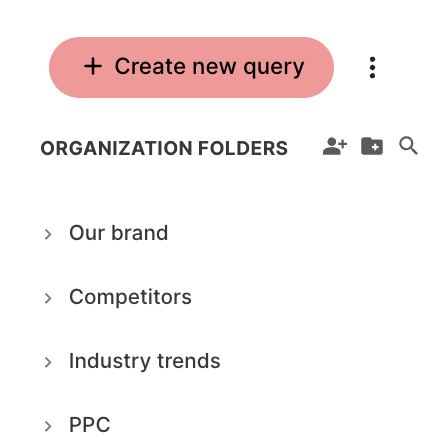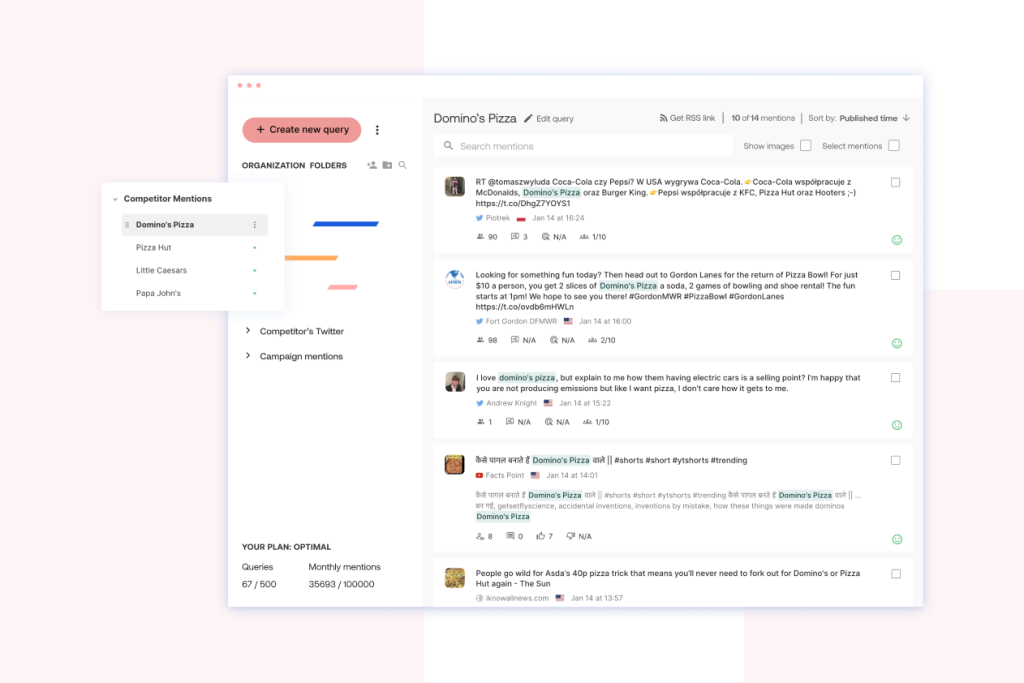Media monitoring uses are vast – and applicable to almost every industry. From pharma to politics, there is hardly any industry that isn’t interested in their competitors, that doesn’t want to follow how their campaigns are performing and that doesn’t care about their brand reputation.
? Read Media Monitoring: The Ultimate Guide
All these use cases make media monitoring an indispensable asset for marketing agencies dealing with multiple clients. Ultimately, it saves time and money, helps keep clients and brings new ones.
How?
Let’s take a look.
Keeping Track of Multiple Clients at Once
Being able to keep track of all your clients’ social media profiles and marketing campaigns is essential to your success.
In theory, you could do it manually. But why bother, when you can get everything in a single dashboard through a media monitoring tool?
Here’s how to set up everything:
Create a folder for each client and track their brand, competitors, relevant hashtags or current campaigns
Add new queries depending on your clients’ differing needs. While one client has just launched a new marketing campaign and needs you to track its corresponding hashtag and audience’s response to it, another needs you to analyze the general sentiment surrounding your brand’s image. Media monitoring tools allow you to keep track of all your clients, across different social media platforms as well as the web in general, all in one place. You are just a click away from switching between clients.

Export reports and analyse relevant data individually for each client
Measure the impact of your campaign through concrete numbers by creating custom charts or choosing between basic report, advanced report and competitive analysis dashboards. Get insight into each of your clients’ mentions and impressions, overall sentiment analysis or get a look at influencer dashboard – know who are the most influential stakeholders for your client’s current campaign goal.
Read 5 PR Report Templates and Hacks to Instantly Prove the Value of Your Work

Set up alerts for each folder (client) and never miss anything
While tracking certain queries, an algorithm calculates the average amount of mentions they’re getting. If your clients start generating more buzz than usual, you’ll immediately be notified. Moreover, if you use real-time alerts, you’ll be the first to know if there is either a positive or negative media upheaval happening right now. Alerts are also great for generally keeping up with each of your clients using digests – a daily or weekly overview of all mentions.
Read Spike Alerts: Get notified when your brand suddenly starts getting more online buzz

Geo mapping
It allows you to constantly be updated about the amount of media buzz around your clients across different countries. This is especially useful for multinational companies as clients as they operate in a number of different locations. As such, it is important to see how clients perform on each specific target market – how are they perceived by the audience and what is the prevailing sentiment. Not only that, but you’ll also be able to track and compare the performance of marketing campaigns across each country.
Read Share of Voice: How to Track It and Why

Market research
Apart from enabling you stay on top of everything going on with your competitors, media monitoring provides a more affordable way of getting insights into your clients’ target audience.
Read How to Do Market Research With a Media Monitoring Tool
Real-time research
More traditional methods of market research, such as surveys and focus groups, gather data that can soon become outdated. Shifts in opinions and perception of the audience are happening every day and the only way to continually keep up with those changes is through media monitoring. Your job as the researcher is now easier – you’re able to capture those shifts, recognize them and act on them just in time.

Unbiased opinions
Avoid mediator’s influence over the respondents’ answers or half-hearted attempts at answering surveys. Instead, get access and insight into freely voiced opinions on clients’ products/services. Consumers are now, more than ever, open about sharing their opinions and concerns on social media. Opinions and concerns that you may have not even considered before. Information such as what new feature do consumers want, what brand do they prefer to another – all readily available.
Competition analysis
Analyze and learn from competitors’ online strategy. You can track all relevant competitors to get insight into consumers’ perception of them as well as their online behavior. Compare your clients to their competitors and strategize how to position them above the competition.
Read Competitor Analysis: Stay Ahead of Competition with Media Monitoring

Landing new clients
Media monitoring can also add value to your pitch for a new client. Here’s a couple of ways how.
Lead your pitch with data in exact numbers instead of guesswork
Analyze social listening results and know how big is your (potential) client’s audience and how that audience is behaving. How many people are currently talking about the brand’s product(s), is the sentiment towards the brand positive or negative, how does the brand perform compared to its main competitors? All that data and more would only be a few clicks away and ready to impress your potential client.
Read Writing a Marketing Pitch: How Social Listening Can Help You Land New Clients
Understanding your clients’ clients
Social listening helps you understand consumers’ needs and behaviors as well as build lasting and profitable relationships with your clients’ audience.
Find and engage a wider range of (potential) customers across social media
Social media monitoring allows you to interact with your audience by replying to their comments or tweets that you wouldn’t have seen otherwise. And while it may seem like a lot of work, there are actual rewards – you can build your social media community, lead people to your website and (potentially) generate sales.
Create quality and personalized content tailored exactly to customers’ needs
Media monitoring gets you insight into whatever’s currently troubling the audience as well as the newest interests and trends. Once you gain this understanding of your audience, the content will come easily.
Analyze the end results of your campaign
Get insight into how your clients’ latest campaigns performed among the audience across different target markets and different social media platforms. Is the prevailing sentiment positive or negative? Is the campaign becoming viral? Answers to all those questions and more are easy to get by practicing media monitoring.
You can see the exact effect a campaign had on your client’s campaign goal. Maybe their aim was to raise brand awareness. How would you go about figuring out if the goal was met? If you use a media monitoring tool – easily.
Let’s assume you and your client agreed upon a list of KPIs for measuring the success of the campaign. You’d want to have insight into the number of brand’s mentions, number of impressions and engagement rate – just to name a few. You’d want this data before and after the campaign, so you can compare the results. If you’ve succeeded in increasing the number of impressions and brand mentions, as well as increasing the engagement rate – you’ve succeeded in reaching your client’s campaign goals.

Make use of the word cloud
Word cloud gets you insight into keywords most used in your mentions – the bigger the word, the higher the frequency. Find out how people see your clients’ brands and what do they associate the most with it. This can help you in several ways – it can show you the wider context in which your keywords are mentioned, it helps identify trends and the common perception of the wanted keywords. As such, it can directly influence the course of your campaigns.
For example if your client was Bershka, you might want to pay specific attention to particular clothing items mentioned here and look at the context. Maybe the customers like these specifically, and emphasizing these in your further campaigns could bring additional benefits to the brand.

Finally
Media monitoring has emerged as an indispensable tool for marketing agencies seeking to thrive in the dynamic world of digital marketing. By actively tracking and analyzing media coverage, social media conversations, and market trends, marketing agencies can gain valuable insights that drive strategic decision-making and enhance brand performance.
The power of media monitoring lies in its ability to transform vast amounts of data into actionable intelligence. By utilizing sophisticated tools and technologies, marketing agencies can sift through the noise, uncover hidden patterns, and extract valuable insights. These insights enable agencies to make data-driven decisions, optimize marketing strategies, and achieve tangible business results.
If you’d like to give media monitoring a try, book a demo and our experts will show you how Determ can bring value to your agency.



